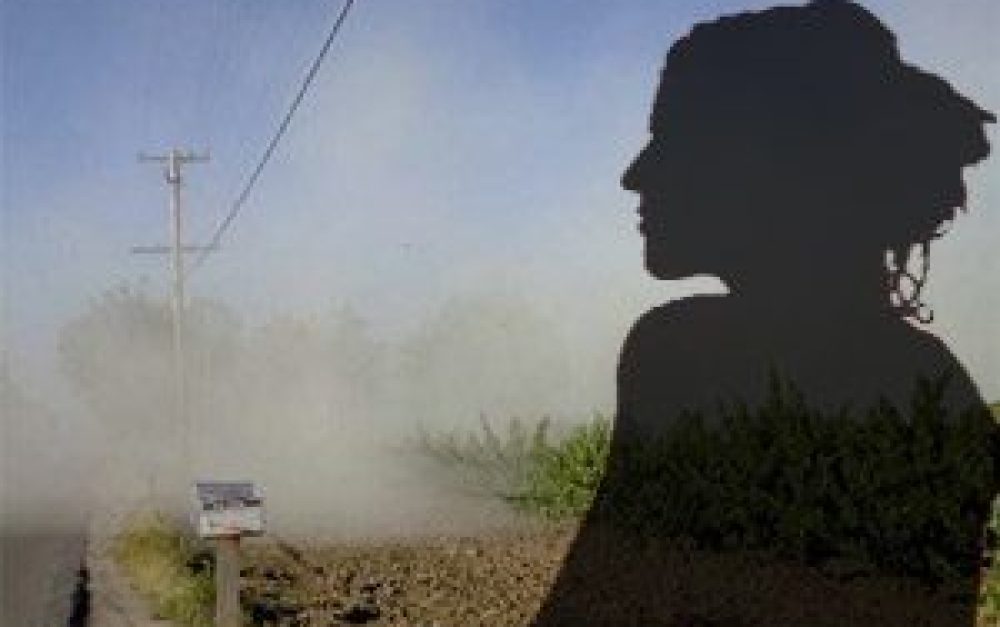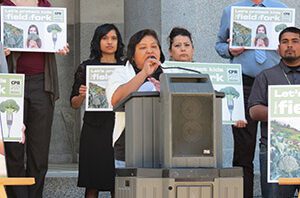When a child’s health is on the line, moms will often stand up in truly courageous ways. Like the mothers in the small, rural community of Lindsay, California who were concerned about how pesticides were affecting their children.
These central valley moms enrolled in a project back in 2006 to monitor how much chlorpyrifos — a commonly used insecticide — was drifting into their homes from nearby fields and orchards, using a simple “Drift Catcher” tool. They also signed up for biomonitoring, a way to find out how much of that pesticide was then making it into their bodies, and likely also into the bodies of their children.
When the results came in, many of the moms went public with what they found, how it made them feel, and what they want done to better protect their families. Below are some excerpts from their powerful stories. The full set of personal stories from the BioDrift Project are available on the Pesticide Action Network website.
Ana Espinoza
I decided to participate in this project because we live near agricultural areas and I am concerned about my daughter and my family’s health. We live in front of a school, and both the school and our home are near orange orchards.
The Drift Catcher in our yard showed high levels of pesticides, and when I went to the doctor, he told me my levels were also high.
I would like more children, and there is evidence that babies can be born with health problems when mothers are exposed. I want to ensure my family is safe. Sometimes I think we should move to another place far away from farming areas, but I know that this would not solve the problem and that we need to participate to make necessary changes.
I understand that we need agricultural products, but we also need authorities to ban bad pesticides from where we work and live.
Metabolite level: 3.8 micrograms/liter
EPA’s “safe” level for pregnant or nursing mothers: 1.5 micrograms/liter
Ernestina Gomez Martinez
I have lived in Lindsay for almost 5 years, working in restaurants most of that time. When I saw the doctor . . . he said that the levels of pesticides in my urine might be from exposure to the pesticides in the air. The first thing that came to my mind is that my baby may be affected, and then I thought about my partner working in the fields and how he might be affected as well.
My test showed high levels, and I think it’s because pesticides can move through the air into the community. I want to share my information with others in order to help make changes that will protect us and our children from dangerous pesticides.
Metabolite level: 7.3 micrograms/liter
EPA’s “safe” level for pregnant or nursing mothers: 1.5 micrograms/liter
Sandra Garcia
I have worked in cauliflower, broccoli, chili and cucumber fields, and in the orange groves.
When I got the test result I felt kind of relieved. I had been wondering what was wrong with me, that I am 48 years old but so often feel at least 58. But now I put things together about my symptoms and spraying season and it makes sense.
I am very concerned about what the pesticide levels in my kids will do to their health, and if some of the self-destructive decisions they may have made are related to how pesticides affect them. In Poplar there is a kind of hopelessness. Maybe part of that attitude is related to how pesticides make us all feel.
Metabolite level: 16.0 micrograms/liter
EPA’s “safe” level for healthy adults: 7.9 micrograms/liter
Luz Medellin Rodriguez
My levels are among the highest of all the participants. Of course I am concerned, but I worry mostly about my children who, like all children, are especially vulnerable to damage from pesticides.
I want the results of my tests to be publicized to awake the conscience of the authorities so they will do something to protect our health. If the pesticide found in my body is banned for use inside our homes, why is it still allowed to be used in fields right next to our homes? It doesn’t make sense.
Metabolite level: 5.3 micrograms/liter
EPA’s “safe” level for pregnant or nursing mothers: 1.5 micrograms/liter
Winning protections
More than 170 million pounds of pesticides are used every year in California, and much of that in the intensive agricultural regions on the central coast and in the central valley. These areas are also home to tens of thousands of families who live, work and play next to orchards and fields, some of which are sprayed regularly with pesticides known to be harmful to children.
Residents in central valley communities like Lindsay worked with Californians for Pesticide Reform to win new “buffer zone” restrictions on applications of the most hazardous pesticides around schools, homes and labor camps.
Personal stories like those shared here by the mothers of Lindsay lend powerful urgency to the need for real reforms to protect children from pesticide drift.
This story appeared at MomsRising.org as part of a blog carnival on clean air and environmental justice.








